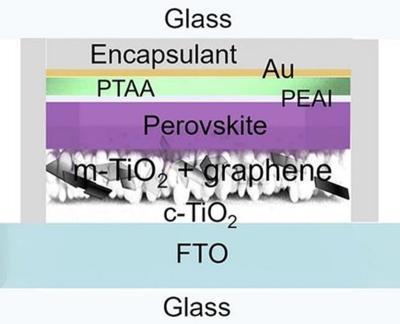Researchers at CHOSE (Centre for Hybrid and Organic Solar Energy, University of Rome Tor Vergata), BeDimensional, Istituto Italiano di Tecnologia and GreatCell Solar Italia recently addressed the stability issues presented by perovskite solar cells, by developing an industrial encapsulation process based on the lamination of highly viscoelastic semi-solid/highly viscous liquid adhesive atop perovskite solar cells and modules.
Sketch of the structure of the mesoscopic n-i-p PSCs. Image credit: Nature Communications
The encapsulant reportedly reduces the thermomechanical stresses at the encapsulant/rear electrode interface. The addition of thermally conductive two-dimensional hexagonal boron nitride into the polymeric matrix improves the barrier and thermal management properties of the encapsulant. Without any edge sealant, encapsulated devices withstood multifaceted accelerated ageing tests, retaining >80% of their initial efficiency.
The encapsulation is applicable to the most established cell configurations (direct/inverted, mesoscopic/planar), even with temperature-sensitive materials, and extended to semi-transparent cells for building-integrated photovoltaics and Internet of Things systems.
“In this work, differently from commercially available PIB-based encapsulants commonly used in literature for perovskite solar cells, we propose low-molecular weight homopolymer PIB as a transparent, viscoelastic, semi-solid liquid processable in form of laminable films,” the scientists stated. “In addition, we show that the adhesion, barrier and thermal management properties of our homopolymer PIB encapsulant can be improved by the addition of two-dimensional (2D) inorganic fillers, namely few-layer hexagonal boron nitride (h-BN) (nano)flakes produced at industrial scale through a patented wet-jet milling (WJM) exfoliation process of the native bulk powder.”
The scientists tested their solution on solar cells fabricated on glass substrates featuring both mesoscopic and planar n-i-p configurations, plus a cell with an inverted p-i-n configuration. A semi-transparent bifacial specimen was also tested. The researchers also made modules based on mesoscopic n-i-p cells made with an absorber relying on methylammonium (MA) perovskite material.
They tested two versions of the novel encapsulant. One with two-dimensional fillers made of a boron nitride material (PIB:h-BN) and one without. The cells measured 1 cm2, while the modules had an active area of 10 cm2, based on 5 cells with an active area of 2 cm2.
The devices were encapsulated at 90 C in a differential pressure lamination process based on an automatic two-chamber solar panel laminator supplied by Italian specialist Rise Technology, along with a cooling system. The cells and modules were subjected to multiple accelerated ageing tests, as well as a customized thermal shock test and a modified humidity freeze test.
“The addition of thermally conductive two-dimensional hexagonal boron nitride into the polymeric matrix improves the barrier and thermal management properties of the encapsulant,” said the team. “Without any edge sealant, encapsulated devices withstood multifaceted accelerated ageing tests, retaining over 80% of their initial efficiency.”
The group sees the work as a step towards long-term stable modules made with low-temperature and cost-effective encapsulants that can be applied in a high throughput manufacturing line, enabling perovskite solar cells to be competitive with conventional crystalline silicon solar technologies. It also foresees compatibility with a wide range of perovskite compositions.
“Overall, our results indicate that semi-solid/liquid encapsulation concepts efficiently mitigate either thermal and thermomechanical stresses during encapsulant application, while providing excellent barrier performance for the realization of long-term stable PSCs and PSMs, aiming at tackling the competition with Si-based PVs,” concluded the team.




